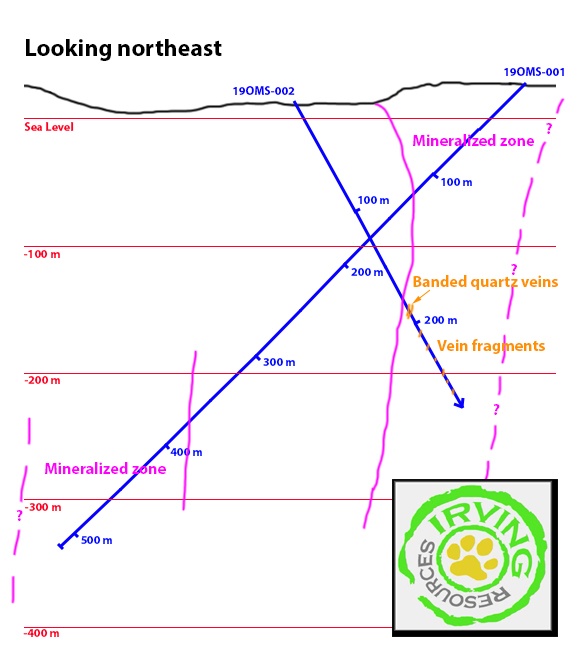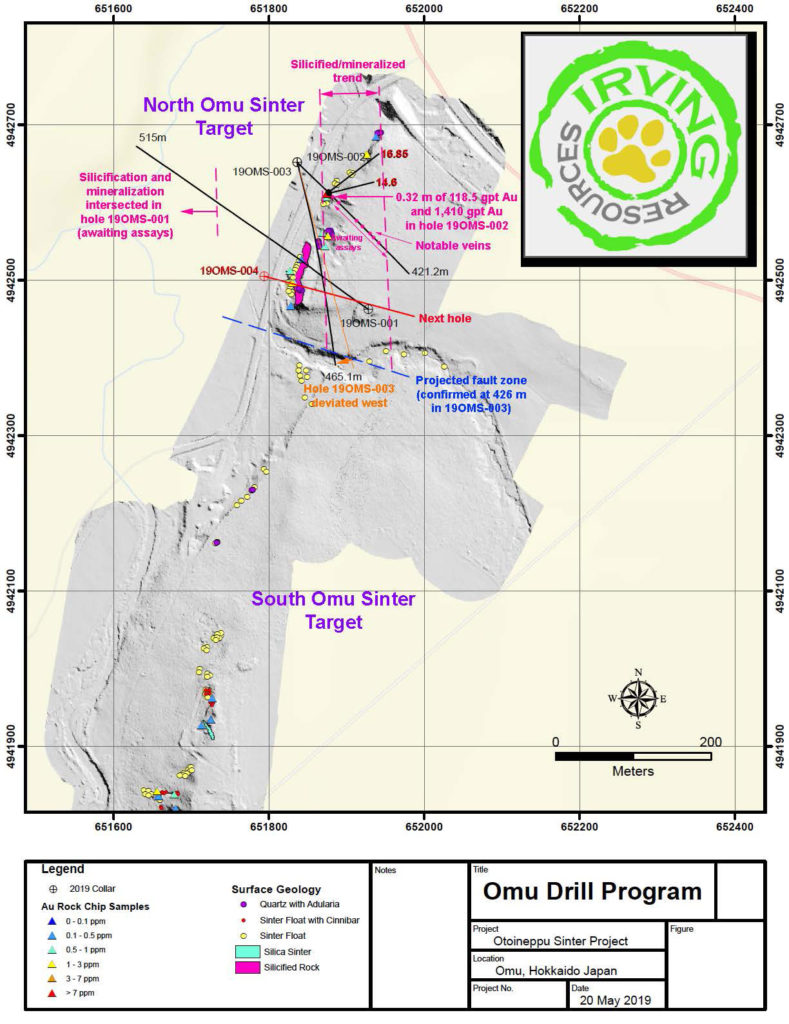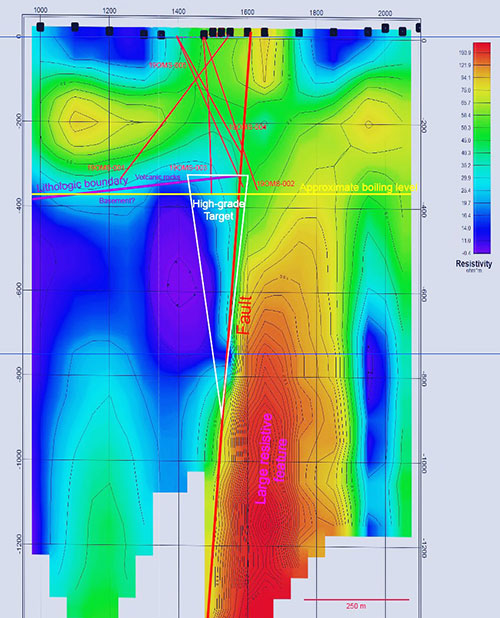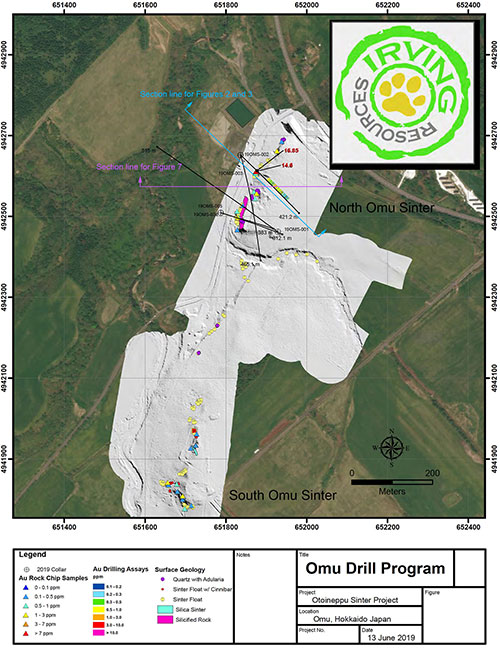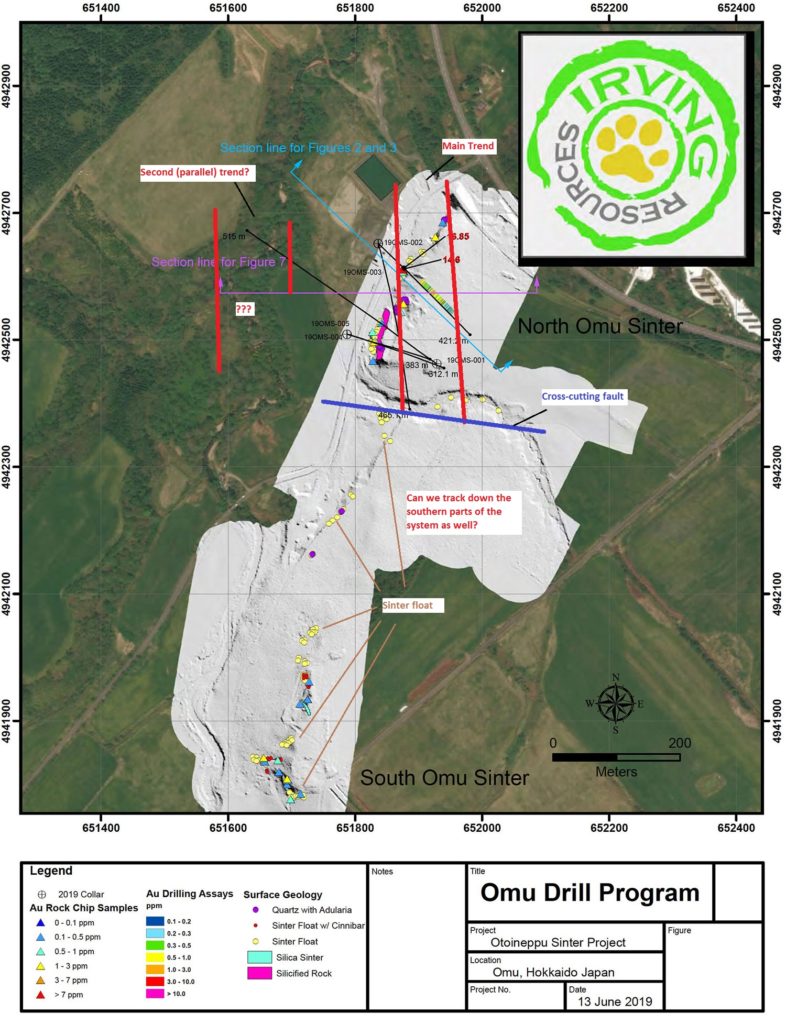Irving Resources: Omu Sinter Updated
Follow me on twitter: https://twitter.com/Comm_Invest
Follow me on Youtube
(Note: I am not a geologist nor am I an investment advisor. The opinions in this article is speculation by me and includes forward looking statements.)
Irving Resources recently completed the 5th hole into the Omu Sinter target, which is one out of three major targets within the greater Omu Project. The only hole that has so far been (partly) assayed is hole #2. This is the hole that generated both a narrow bonanza-grade interval of 0.35m which graded 135 gpt AuEQ as well as broad minerlized interval that graded 1.02 gpt AuEQ over 152m. The top 182m of hole #2 is yet to be assayed.
In the latest news release we learned that after conducting a study at the Omui Mine (the second target to be tested) the findings indicated that the “boiling zone” starts at approximately 380m below the surface. This in turn led to the hypothesis that boiling zone at Omu Sinter might also start at similar depths. This is important because the boiling zone is usually where the best and richest mineralization is located in a Low Sulfidation Epithermal system.
So far there has no been drilling into the theoretical boiling zone which is an encouraging sign given that significant mineralization has already been encountered hundreds of meters above the boiling zone and Irving is planning to drill test Omu Sinter at depths up to 700-900m. Given that the vein material in hole #2 which graded 135 gpt AuEQ was encountered at a depth of 150m, it goes without saying that the theoretical upside is very large, at this point in time.
Even though the drill equipment able to drill deeper holes are not yet on site, I think there is potential for some eye opening results out of hole #4, #5 and probably #3. Furthermore, there are encouraging signs, in my opinion, why Omu Sinter looks increasingly prospective and that there is a real possibility that we will view the Omu Sinter project very differently when we start punching in some deeper holes etc. Let me explain why I think that…
In the April 22 news release we got this slide:
… As you can see there hole #1 intersected two mineralized zones. Both the “main trend” which has been the focus of the later holes as well as another trend further west.
Then in the May 22 news release we got this tidbit:
“Hole 19OMS-003 was drilled in a south-southeasterly direction at an inclination of 55 degrees and was designed to test southern extensions of mineralization encountered in hole 19OMS-002 (please refer to the Company’s press release dated May 6, 2019 for further information) as well as confirm the presence of an east-west trending structure in this area (Figure 1).”
Accompanying figure (figure 1.):
… As you can see there is one north-south trend (“main trend”), a northwest-southeast cross-fault which cuts right through the main trend as well as an additional trend to the west of the main trend, which is assumed to be parallel with the main trend.
There was another interesting tidbit in the same news release:
“Veining, vein breccias and sulphide mineralization similar to that seen in hole 19OMS-002, was observed in hole 19OMS-003 (Figures 2, 3 and 4). Intensity of pyrite was particularly high immediately before encountering the cross structure, a fault that appears to have displaced the system following emplacement. “
Fast forward to the most recent news release from June 13:
Tidbit #1:
“Two phases of mineralization are evident at Omu Sinter, an early Ag-rich phase and a later Au-rich phase.”
Tidbit #2:
“Irving believes there were two phases of mineralization at Omu Sinter, an early silver-rich phase followed by a later gold-rich phase. Vein material associated with the early silver-rich phase typically displays banded white quartz along with thin seams of black, Ag-bearing sulfide minerals termed “ginguro”. Where high gold values are present, bands of pyrite and/or marcasite are present in and around quartz veins. Holes 19OMS-004 and 19OMS-005, both recently completed, encountered intervals of banded veins displaying pyrite and marcasite (Figure 4 and 5) as well as multiple vein intervals displaying ginguro. Of particular note is a nearly 7.5 m long interval of quartz-pyrite-marcasite vein material intercepted in hole 19OMS-005 beginning at approximately 334 m”
Tidbit #3:
“Many veins encountered in holes 19OMS-002 are notably brecciated with vein fragments floating in intensely clay altered volcanic rock. Intense clay alteration is widespread in shallow portions of the Omu Sinter hydrothermal system as it is in most hot spring epithermal deposits. Irving believes such vein brecciation formed when movement occurred along the principal fault during mineralization causing ductile clay to deform thus breaking apart newly formed veins. Because this movement appears to have occurred during early stages of mineralization, many of the vein and vein breccias encountered in hole 19OMS-002 display high silver-to-gold ratios, especially proximal to the principal fault (Figure 3). Irving believes breakage of these veins disconnected them from the underlying “plumbing” system before the main gold depositional phase“
We also got these two slides:
… Note that it looks like there is a north-south trending fault structure just to the east of the main mineralized trend.
To summarize the information presented so far (my interpretation):
- It looks like there is an additional trend of mineralization, parallel to the north-south “main trend”
- There looks to be a fault just east of the “main trend”, the “principal fault”
- There looks to be a cross-cutting northwest-southeast fault that cuts the “main trend”
- The “principal fault” is assumed to have been active during the first Ag rich mineralization event
- Many of the veins and vein breccias encountered in hole #2 looks to have disconnected from the underlying “plumbing system” before the second gold rich event took place
- They also show high Ag/Au ratios
- Intensity of pyrite was particularly high immediately before encountering the cross-structure (fault)
- Vein material associated with the early silver-rich phase typically displays banded white quartz along with thin seams of black, Ag-bearing sulfide minerals termed “ginguro”
- Where high gold values are present, bands of pyrite and/or marcasite are present in and around quartz veins.
Discussion
Irving has so far drilled along the “main mineralized trend” which is proximal and parallel to the “principal fault” within the “North Omu Sinter” area. There is also a fault confirmed which cross-cuts the main trend and due to displacement of the said trend, the Omu Sinter target has thus been split into the “North Omu Sinter target” and “South Omu Sinter target”. In the overview picture one can see that “sinter float” has been found along a trend which measures over 800m. The fact that sinter float has been found in the “South Omu Sinter” area, is potentially a good sign that a continuation of the main trend is preserved and that Irving might be able to locate it in the future, which is a big plus.
The fact that intensity of pyrite increases in proximity to the cross-cutting fault is interesting. I do not know what importance that might have since it is believed to have displaced the system FOLLOWING emplacement.
The second (parallel) mineralized trend is something that might be a big deal though. Irving stated the following in the April 22 news release:
“Several small, but significant silica-pyrite veins present near the end of hole 19OMS-001 might suggest proximity to a feeder in this area.”
I take that statement as a possibility that there might potentially be two mineralized trends with a potential feeder (and boiling zone) just a few hundred of meters away from each other. Again, we have only really started to test the (eastern) “main trend” so far. Thus, additional positive surprises should probably not be ruled out.
What is potentially most exciting is the notion that most of the (so far assayed) interval in hole #2 encountered vein material which was primarily created/enriched during the first silver rich event…
What could happen to AuEQ grades if there are areas deeper down where there might be less (soft) clay material and where there might be more material that got enriched by both events due to more intact “plumbing”?
Furthermore Quinton has aired a theory that mineralized fluids might have been trapped deeper down since the principal fault seems to have messed up the “plumbing”…
Did fluids from primarility the second gold rich event get trapped, and was forced to spread out in and around the indicated unconformity, which looks to have similarities with the geological setting at Hishikari?
If so, there might be a substantial prize to be found when we drill the deeper targets as outlined by the geophysics (fig. X above).
Closing Thougths
Irving Resources is just beginning to unlock the Omu Sinter Target which is one of the three known main targets within the greater Omu Project. We have yet to see what might be found in the main prize at Omu Sinter, the boiling zone. Given that Irving seems to be getting better and better with drill targeting, with a lot of help from Newmont Goldcorp, it shouldn’t be a surprise that hole #5 looks very interesting. That hole hit a 7.5m interval (yet to be assayed) at approximately 340m depth that contained material which reminds me of some of the bonanza-grade breccia material found at surface near Omui. We are talking lots of quartz fragments, “ginguro” banding and lots of pyrite. Remember, the dark ginguro is supposedly tied to high-grade silver mineralization and quartz with pyrite inside and around it is supposedly tied to high-grade gold mineralization:
… Again keep in mind that this might not even be from the actual boiling zone, or perhaps just at the start of it.
Lastly to give you a visual representation of what seems to be going on at Omu Sinter I have added some drawings on the latest drill map:
(Note: This is not investment advice and I am not a geologist. Always do your own due diligence. I personally own shares of Irving Resources which I have bought in the open market and I am probably biased.)
Best regards,
The Hedgeless Horseman
Follow me on twitter: https://twitter.com/Comm_Invest
Follow me on Youtube
Follow me on CEO.ca: https://ceo.ca/@hhorseman



